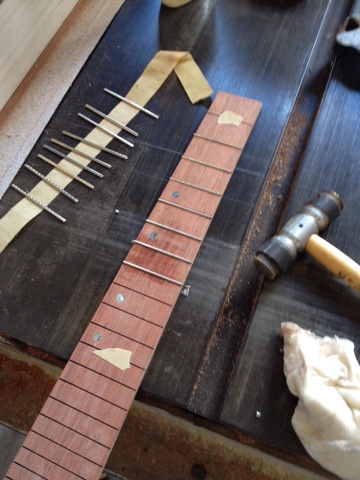We're getting close to finishing our ukes, Mike assures us, but still there's a ton of work for us to do today.
I recently read a luthier's statement where he said the to make a ukulele involves more than 100 steps... now I believe it!
First we measured, marked and then drilled the tuner mounting holes.
This is my pal Stan's headstock, similar shape to mine but with a black walnut veneer to match the wood on the back and sides of his uke.
Here's Werner's headstock with its attractive rounded shape.
We move on to work on sizing and shaping our nut and saddle. These two critical pieces gave me some grief as my lack of precision sanding skill brought down some wrath from our instructor. I sucked in my pride and consoled myself by realizing that I had the instrument almost built now so if I screwed up in these final steps I could certainly seek the help of local luthier friends when I returned home. Boosted by this back up plan I humbly dragged myself along.
Here's the two small troublesome bits, the chunks of white material:
Next we turned our attention to dressing the frets which is a process I had been curious about. Lucky for me I had good success with this step!
We marked to top of each each fret with a felt pen then used a simple flat edge to check for unevenness. Hurray, mine were already fairly even! Thanks gawd for doing something correctly! Then we took a special tool and crowned each fret after which we sanded the edges followed by polishing each one . And finally, we scraped between the fretwire with a razor blade's edge. Three diiferent coarseness pads served to smooth sand the entire fretboard.
To finish off the fretboard, we applied fretboard oil, similar to mineral oil, to the fingerboard. Mike reminded us that we could do this every 6 months or so when we change the uke's strings.
The last task of the day was to practice applying tru oil which we will actually sand off tomorrow so we can sand with even finer grits and the apply the actual final coat of oil. Looks pretty good at this point I think with an overwhelming feeling of relief!





























































